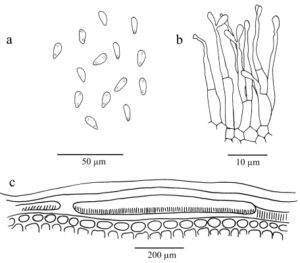Aoria Cif., Atti Ist. bot. Univ. Lab. crittog. Pavia, Ser. 5 19: 89 (1962)
Index Fungorum number: IF 7183, MycoBank number: MB 7183, Facesofungi number: FoF 07112, Fig. 1
Parasite on the host plant in terrestrial habitat. Sexual morph: undetermined. Asexual morph: Conidiomata black, stromatic, solitary, occasionally confuent, subepidermal in origin, immersed, multilocular, glabrous. Ostiole absent, dehiscing by irregular ruptures in the apical wall and overlying host tissue. Conidiomatal wall composed of three cell types: (a) basal wall of textura angularis with thick-walled, dark brown to subhyaline cells; (b) inter-locular tissue of textura porrecta with thick-walled, black to dark brown cells; (c) upper wall of textura angularis with thinner-walled, brown to hyaline cells, which is packed with brown fungal tissue of textura angularis to textura epidermoidea. Conidiophores arising from innermost layer of basal stroma, hyaline, cylindrical to subcylindrical, tapered to the apex, unbranched or branched immediately below the transverse septa, smooth-walled. Conidiogenous cells hyaline, holoblastic, sympodial, lageniform, integrated, indeterminate, loci indistinct, smooth-walled. Conidia hyaline, ellipsoid with broaden and obtuse apex, and narrow, acute base, unicellular, smooth-walled, guttulate (Sutton 1980; Morgan Jones 1972).
Type species – Aoria amphistroma Cif., Atti Ist. bot. Univ. Lab. crittog. Pavia, Ser. 5 19: 89 (1962)
Notes – Aoria amphistroma is associated with tar spot on leaves of Lyonia sp. (Ericaceae) in Dominica (Sutton 1980). Aoria shares a similar form of conidiomata with the asexual morph of Rhytisma (= Melasmia), but the latter was separated from the former by its enteroblastic, phialidic, conidiogenous cells and cylindrical conidia (Sutton 1980). The genus is monotypic and no molecular data. New collections are needed and subjected to DNA analyses to place Aoria in
a natural classification.
Distribution – Dominican Republic (Sutton 1980).

